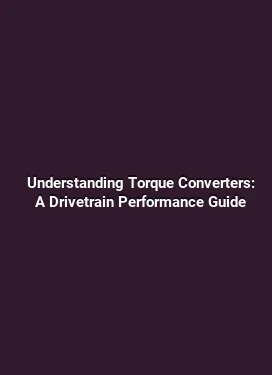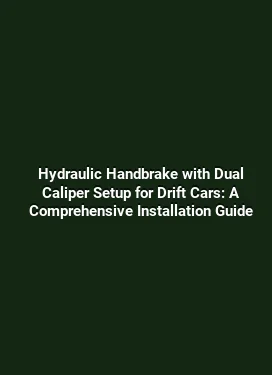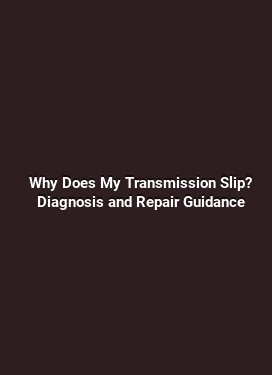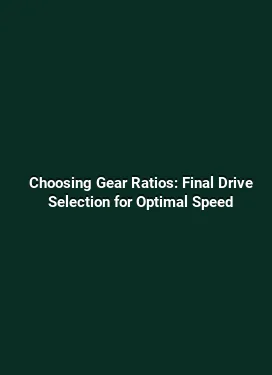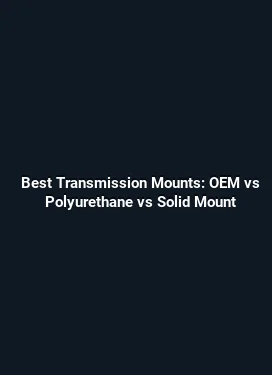CV Joint Replacement: A Step-by-Step DIY Drivetrain Tutorial
Understanding the CV Joint and Its Role in the Drivetrain

Constant-velocity (CV) joints are critical components that transfer rotational power from the transmission to the wheels while accommodating suspension movement and steering. There are two common types found in passenger vehicles: outer CV joints near the wheel and inner CV joints near the transmission. The most prevalent designs are the Rzeppa (outer) and tripod (inner) configurations. A well-functioning CV joint maintains smooth power delivery, minimizes vibrations, and preserves axle integrity. Symptoms of a failing CV joint include clicking during tight turns, grease leakage, clicking or clunking noises when accelerating, and noticeable driveline vibrations at certain speeds. Recognizing these signs early helps prevent further drivetrain damage and reduces the risk of a roadside failure.
In modern vehicles, CV joints work with CV boots that seal lubrication and keep contaminants out. Over time, boots crack or tear, leading to grease loss and accelerated joint wear. Replacing a CV joint or boot before catastrophic failure can save time and money. This tutorial provides a comprehensive, step-by-step approach to performing CV joint replacement in a typical front- or rear-wheel-drive setup. While some steps are model-specific, the core principles—safety, diagnosis, disassembly, replacement, reassembly, and testing—remain universal across most platforms.
Preparation: Planning, Tools, and Safety Protocols
Before touching any drivetrain components, assemble the right tools and a safe workspace. A well-prepared bench or garage with adequate lighting, a stable vehicle stand or ramps, and a clean area for parts minimizes the risk of injury and lost components. Essential tools typically include a socket set with metric sizes, a torque wrench, pry bars, snap ring pliers, needle-nose pliers, a hammer or mallet, a malleable punch, a CV boot clamp tool, and a torque wrench compatible with the vehicle’s fasteners. For boot installation, a boot clamp crimping tool or wire ties designed for CV boots ensures a secure seal. Some models may require a hub puller or special adapters to access the CV joint assembly.
Safety cannot be overstated. Park on a flat surface, engage the parking brake, and use wheel chocks. If lifting the vehicle, use jack stands rated for the weight and place wheel chocks on the opposite end. Disconnect the negative battery terminal if there is any risk of tools triggering electrical systems during the job. Wear cut-resistant gloves, eye protection, and sturdy footwear. It is essential to follow the vehicle manufacturer’s specifications for torque values and reassembly procedures, as incorrect tightening can cause premature joint failure or wheel-off incidents.
Diagnosing the Problem: When to Replace the CV Joint or Boot
Begin with a systematic assessment to confirm that a CV joint or boot replacement is the correct remedy. Perform a visual inspection to locate torn boots, dried grease buildup around the wheel hub, or grease spewing from the boot seam. Use a flashlight to inspect for hairline cracks, missing clamps, or punctures along the boot. Conduct a road test to reproduce symptoms: a sharp click when turning indicates outer joint wear, while a constant vibration at highway speeds may signify inner joint wear or axle imbalance. A thorough diagnosis also includes checking the axle shaft for straightness and inspecting the wheel bearing for abnormal play, as a failing bearing can mimic CV joint symptoms. Properly diagnosed wear minimizes the risk of unnecessary disassembly.
Note that not all CV joint wear requires a full joint replacement. In some cases, replacing only the boot and re-lubricating with appropriate grease is enough if the joint hasn’t sustained significant wear. However, if metal debris is found in the old grease, or the joint shows excessive play, replacement is the prudent path. This guide focuses on replacing the CV joint assembly and re-sealing with a new boot and clamps to restore proper function and longevity.
Disassembly: Accessing the CV Joint and Preparing for Replacement
The disassembly phase requires careful handling to prevent damage to surrounding components. Start by loosening the wheel lug nuts while the wheel is still on the ground. Lift the vehicle, secure it on stands, and remove the wheel. Next, identify the axle connection to the wheel hub, typically secured with a large axle nut or multiple fasteners at the hub. Remove these fasteners and slide the axle shaft away from the hub, taking care not to damage the ABS sensor ring or tone ring if equipped.
With the axle free from the hub, gently separate the inner CV joint from the transmission or differential—this step often requires prying or tapping with a mallet, but use a protective shim to avoid contact with the transmission housing. For outer joints on independent suspension layouts, you may need to detach the control arm or axle housing to provide clearance. As you work, keep track of parts and their orientation. A magnetic tray or labeled bags prevents misplacement of snap rings, boots, and clamps.
Inspect the boot clamps and the joint housing for wear indicators, such as torn boots, loose clamps, or metallic shavings within the joint cavity. If debris is present, it’s a sign of contamination that necessitates complete joint replacement rather than boot-only repairs. When removing the joint, note the retaining method (snap rings, bolts, or press-fit design) and keep track of the order of components. Cleanliness is paramount; wipe surfaces with a lint-free cloth and avoid introducing grit into the joint cavity.
Key Steps in Disassembly

1. Remove the axle from the hub and secure it in a vise or on the workbench, if feasible, to prevent it from rolling. 2. Detach the outer boot clamp and slide the boot back to expose the CV joint race. 3. Remove the snap ring or retaining clip that holds the joint to the axle shaft. 4. Gently separate the joint from the axle by applying even pressure with a pry bar or a specialized CV joint puller. 5. Clean the joint housing and inspect the joint for wear, scoring, or pitting. 6. If replacing the inner joint, detach the transmissions-side retaining mechanism and slide the joint out of the transaxle or differential case. 7. Prepare the new joint with fresh grease and inspect the mating surfaces for burrs or irregularities.
Choosing and Preparing the Replacement CV Joint
Selecting the correct replacement CV joint is crucial. Use the vehicle’s VIN, service manual, or OEM part number to identify the exact configuration—outer vs. inner, and the specific joint type (Rzeppa, tripod, or ball-type, depending on design). High-quality OEM or aftermarket joints from reputable brands offer robust performance and a longer service life. When inspecting the replacement, verify that the joint has a fresh, clean grease fill and that seals and boots are in pristine condition with intact clamps. If the kit includes a boot, ensure the boot style matches the original (with corresponding clamp type and sizing). A common upgrade practice is to replace the boot and clamps along with the joint to guarantee a sealed, long-lasting assembly.
Lubrication is a critical consideration. CV joints rely on grease with specific viscosity and load-carrying capabilities. Do not reuse old grease from the failed joint; discard it and apply fresh grease per the manufacturer’s specification. Some kits include pre-filled grease, while others require manual packing. Thorough lubrication reduces friction, heat, and wear, extending joint life.
Reassembly: Installing the Replacement CV Joint
Reassembly begins with aligning the joint and the axle shaft. Grease the joint thoroughly, ensuring the grease coats all ball or roller elements and the race surfaces. Slide the joint onto the shaft, taking care to prevent pinched seals or damaged boots. Reinstall the boot over the joint, ensuring the boot sits evenly without twists. Secure the boot with new clamps; if using a crimping tool, ensure a uniform crimp around the boot’s circumference for an airtight seal. Refit any retaining clips or bolts as required by the design. Before reattachment to the hub, inspect the mating surfaces for burrs or contaminants that could compromise seal integrity.
With the axle prepared, reinsert the shaft into the hub or transaxle. Torque the hub fasteners to the manufacturer’s specification. Refit the wheel onto the hub, finger-tighten the lug nuts, and then lower the vehicle to the ground. Use a torque wrench to tighten lug nuts to the recommended pattern and torque value to ensure even clamping and wheel safety. If the drivetrain includes an ABS sensor, reconnect the sensor connector and verify that the sensor ring is properly aligned and free of debris. Recheck all clamps and fasteners to ensure nothing is loose or misaligned.
Torque Specifications and Alignment Considerations
Correct torque is essential for joint longevity and wheel safety. Refer to the vehicle’s service manual for precise values. In many cases, wheel hub-to-knuckle bolts, axle nut torque, and lug nut torque require different settings. After assembly, perform a gentle spin by hand to confirm the joint’s smooth operation and listen for any abnormal noises at low speeds. A road test should follow, initially at slow speeds to verify quiet operation, followed by gentle acceleration to monitor for vibrations or abnormalities. Alignment checks may be prudent if the axle or suspension components were disturbed during disassembly, ensuring tire wear is even and handling remains stable.
Testing, Troubleshooting, and Preventive Care
After installation, thorough testing confirms the repair’s success. A quiet, smooth operation during initial drive cycles indicates proper seating of the joint and boots. Listen for clicks when turning at low speeds, which would signal inadequate boot sealing or misalignment. If you hear new noises or feel driveline vibrations during acceleration or deceleration, re-check boot clamps, joint seating, and axle installation. Inspect the CV boot for any signs of twisting or kinks, which can cause leak paths or compromised joint protection. Check for grease leakage at the boot seams after the first drive cycle, as residual manufacturing grease may appear briefly but should dissipate once the system seals fully.
Preventive care extends the life of the CV joints. Regular inspections of the boots for cracks or tears, and monitoring for grease seepage around the wheel, help catch issues early. If a boot shows wear, replace it promptly to avoid contaminated grease and accelerated wear. When performing future maintenance, such as brake work or suspension service, take advantage of the exposure to inspect CV boots and joint seals. Maintaining a clean environment around the axle assembly reduces the risk of grit entering the joint, which can accelerate wear and degrade performance.
Common Pitfalls and Practical Solutions
DIY CV joint replacement carries challenges. One common pitfall is not fully seating the inner joint, which can cause axle play and vibration. To prevent this, verify that the joint seats fully against the transmission or differential housing and that the retaining mechanism is secure. Another frequent issue is boot clamp misalignment, leading to leaks or torn boots. Using a proper boot clamp tool and aligning clamps before crimping stops this problem. Additionally, using the wrong grease or insufficient lubrication can shorten joint life. Always match grease type and quantity to the guidance in the replacement kit or the vehicle’s service manual. Finally, improper torque on axle nuts and hub fasteners can compromise wheel bearing life and safety; double-check torque at the end of the procedure with a calibrated torque wrench.
Long-Term Considerations: Driving Habits and Monitoring
After completing CV joint replacement, adopting protective driving habits extends the durability of the new joint. Smooth steering inputs, avoiding aggressive clutch or throttle application when turning, and maintaining balanced tire pressures reduce load spikes on the drivetrain. Regular inspections—every 5,000 to 10,000 miles or as recommended by the vehicle manufacturer—help catch early signs of contamination or boot wear. If a new vibration appears after replacement, consider rechecking the CV joint seating, boot clamps, and hub alignment as part of routine maintenance. Keeping a log of inspection findings and replacement dates supports proactive drivetrain management and helps plan future service intervals.
Conclusion: Key Takeaways for a Successful CV Joint Replacement
Effective CV joint replacement hinges on thorough diagnosis, careful disassembly, precise reassembly, and meticulous testing. Selecting the correct joint type, preparing with the right tools, and following manufacturer torque specifications are essential. Boot integrity, proper lubrication, and clean handling prevent contamination and ensure longevity. With careful execution and attention to detail, a DIY CV joint replacement can restore drivetrain performance, reduce noise, and extend the life of the axle system, enabling confident, smooth operation across a wide range of driving conditions.

